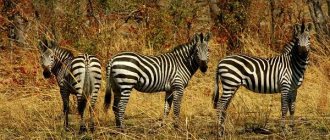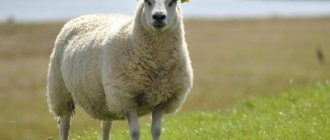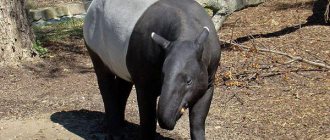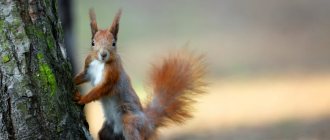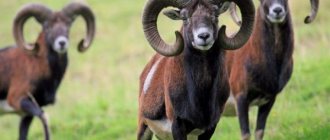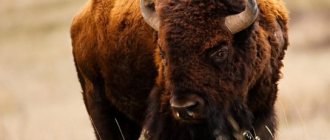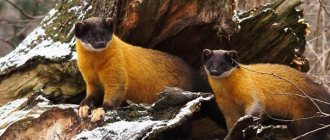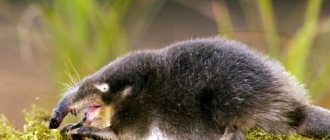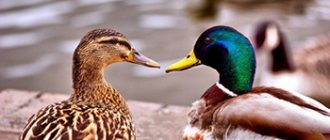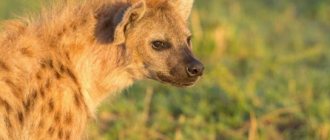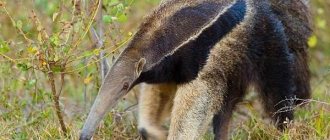- Wild animals
- >>
- Mammals
Vicuna is a cute animal, at the same time reminiscent of llamas and camels (only in smaller dimensions). This is an ancient species of mammal. Known references to it date back to 1200. The animal was sacred to many peoples of the Andean foothills. Here the vicuñas bore the honorary title “Golden Fleece.” At the same time, its wool was highly valued (as it still is today) and was intended for sewing royal robes. However, killing animals was prohibited.
Description
— Advertising —
The body length of the vicuña reaches 150 cm, the height is about 1 m, the weight of adult individuals is up to 50 kg. The color of the back is light brown, the belly is lighter. The fur is thick and soft, tousled. The lower incisor teeth of the vicuña constantly grow, like those of rodents. This anatomical feature is not found in other species of artiodactyls.
Links[edit]
- ^ abcde Acebes, P.; Wheeler, J.; Baldo, J.; Tuppia, P.; Liechtenstein, G.; Hoces, D.; Franklin, W. L. (2018). "Vicugna vicugna (revised version published 2022)". IUCN Red List of Threatened Species
.
2018
: e.T22956A145360542. Retrieved February 15, 2022.CS1 maint: ref=harv (link) - vicuña
spelling is not even mentioned in some dictionaries, such as the Macmillan Dictionary. - vicugna
spelling is so rare in English that it is not even listed in the Columbia Electronic Encyclopedia or any major dictionary, including the
American Heritage Dictionary
,
Merriam-Webster Online Dictionary
,
Oxford Living Dictionaries
,
Random House Dictionary
,
Collins English Dictionary
, and
the Longman Dictionary of Contemporary English. - Wilson, Delaware; Reader, D.M., ed. (2005). Mammal Species of the World: A Taxonomic and Geographical Guide (3rd ed.). Johns Hopkins University Press. ISBN 978-0-8018-8221-0. OCLC 62265494.
- Wheeler, Dr. Jane; Cadwell, Miranda; Fernandez, Matilda; Stanley, Helen F.; Baldi, Ricardo; Rosadio, Raul; Bruford, Michael W. (December 2001). "Genetic analysis reveals wild ancestors of llamas and alpacas". Proceedings of the Royal Society B: Biological Sciences
.
268
(1485):2575–2584. DOI: 10.1098/rspb.2001.1774. PMC 1088918. PMID 11749713. 0962-8452 (paper), 1471-2954 (online). - Jump up
↑ Hogan, C. Michael (December 7, 2008).
Strömberg, N. (ed.). "Guanaco: Lama Guanico". GlobalTwitcher.com
. GlobalTwitcher. Archived from the original on March 4, 2011. - Schuhmacher, Eugen (1 January 1968). Last of the Wild: On the Trail of Rare Animals. Collins. paragraph 304.
- "Species Profile: Vicugna (Vicugna vicugna)". US Fish and Wildlife Service. Archived from the original on February 1, 2009. Retrieved January 4, 2009.
- Roberson, Mary-Russell (January–February 2008). "Discovery of the camels of South America". Smithsonian Zoogoer
. National Zoological Park, Smithsonian Institution, Washington, DC, USA: Friends of the National Zoo. Archived from the original on March 21, 2008. Retrieved May 16, 2010. - Bonacic, Christian; Gimpel, Jessica (1 January 2003). Lemons, John; Victor, Reginald; Shaffer, Daniel (ed.). Sustainable Use of Vicuña: A Critical Analysis and the MACS Project
. Springer USA. p. 348. DOI: 10.1007/978-1-4615-0375-0_24. ISBN 978-1-4613-5045-3. - Coggins, David (20 September 2013). “Why does a Vicuña jacket cost $21,000?” . The Wall Street Journal
.
Vicuna distribution
— Advertising —
The vicuña's natural habitat spans the Andes Mountains in Ecuador, Peru, Bolivia, Argentina and Chile. In these areas, animals live at altitudes from 3500 to 5500 m above sea level.
Vicunas are widespread on rocky and gravelly plateaus, pampas, high plateaus and semi-deserts poor in vegetation.
Features and habitat of the vicuña
Vicuna (other names - vigoni, vicuni, vigon) is a ruminant animal belonging to the camel family of the llama genus. Outwardly, the llama vicuña more closely resembles a guanaco or alpaca, and is only vaguely similar to a camel, since it has no humps and is much smaller in size.
Unlike the camel, it is found only in South America, in its western part - in the highlands of the Andes (in the territory of the modern states of Chile, Peru, Ecuador, Bolivia and Argentina). Vicunas live at an altitude of 3.5 to 5.5 kilometers, in rather harsh conditions.
The animal is graceful and slender. The length is approximately one and a half meters, the height at the withers is about a meter, and the average weight is 50 kg. The fur is a little disheveled, but soft and thick, just enough to save the animal from cold, wind, rain and other bad weather. Thus, alpacas, llamas, guanacos, and vicuñas are very similar to each other.
Common Vicuna Types
Vicuña is the only representative of its genus that is contrasted with llamas and camels, due to the structural features of the vicuña’s jaws and teeth. Their closest relative is the guanaco, as evidenced by the fact that vicuñas and guanacos mate.
From the vicuña comes the domestic animal alpaca, which is bred in the high mountain regions of the Andes. It is considered either as an independent species Vicugna pacos or as Lama pacos. Although scientists previously believed that vicunas were not domesticated, and llamas and alpacas descended from guanacos. Animal DNA studies now indicate that the alpaca's ancestors are still vicuñas. Determining the exact origins of these pets is difficult, since alpacas, llamas, guanacos and vicuñas can mate with each other, and have interbred quite often.
Nutrition
Like guanacos, owners of the golden fleece often lick limestone stones and rocky areas saturated with minerals, and do not disdain salt water. Vicuna feeds on low-growing grasses.
High mountain areas are not rich in vegetation; only tufted perennial grasses, poor in nutrients, grow here, including cereals. So the Andean inhabitants are unpretentious.
They are especially active in the morning and at sunset. If the summer is dry and hot, then during the day vicuñas do not graze, but lie and chew hard stems picked at dawn, like camels.
Vicuna behavior
Vicunas, like guanacos, live in family herds in limited areas. In such a natal herd live a dominant male, from 5 to 15 females and young animals. In addition, there are also separate groups of young single males, whose immature age does not allow the animals to protect their own territory. Such bachelor males create temporary herds of 20-30 animals. There are also lonely old males who have been driven out of the family herd by younger rivals. Sometimes they join groups of young bachelors.
Vicunas are active during daylight hours and rest at night. During the day, they slowly move along the mountain slopes in search of food, and after eating they bask in the sun.
Vicuñas are calm and phlegmatic, often approaching people and living areas, but they are very moody. In captivity, they usually refuse food and water and do not make contact with people. Therefore, it has still not been possible to tame vicuñas.
Gallery[edit]
- Vicuna on the coat of arms of Peru
- Comparison of alpaca, llama and vicuña (1914)
- Vicuna on Rocky Terrain (2008)
- Vicuñas on the road to the El Tatio geysers, San Pedro de Atacama, Antofagasta region, Chile (2011)
- Vicuna in the province of Jujuy on the Argentine Altiplano (2011)
- Vicuña Fawn in the Atacama Desert (2014)
- Vicunas in Salar de Chalviri, Bolivia
Vicuna breeding
The mating season for vicuñas lasts from April to the end of June. The duration of pregnancy is about 11 months. Females bring offspring every year. Foals live with their mother for up to 1 year, then for 1.5-2 years in the herd, and only after that they begin an independent life.
Under natural conditions, vicuñas live 15-20 years.
Reproduction and raising offspring
The rut of vicuñas occurs in March-April, and after 11 months the females give birth to one baby at a time. The cub is born as a small copy of its parents, only even cuter. He is extremely mobile and follows his mother within 15-30 minutes after birth. 2-3 weeks after giving birth, the new mother again participates in the marriage ceremony; adult healthy females give birth to cubs every year.
Young animals stay with their mothers until almost one year of age, then leave the group. Males join the bachelor herd, and females try to join another harem group. This animal behavior prevents inbreeding (inbreeding), and the size of the parental group remains more or less constant, which is very important in conditions of extremely scarce food resources.
Domestication of the vicuna
Vicuñas helped the indigenous people of the Andes, the Incas, to survive in harsh conditions. Their meat was eaten, their skins were used to make clothes, and their bones were used to make tools. With the help of vicuñas, domestic animals such as llamas and alpacas were bred.
Over time, vicuñas began to be treated as sacred animals; according to legend, wild animals were herds that belonged to the gods, and their wool was called the golden fleece. Vicuñas have also been found in many Andean cave paintings. At that time, the extermination of vicuñas was prohibited. To obtain wool, vicunas were caught, sheared, and the animals themselves were released. Thanks to this, the animal population was stable.
The number of vicuñas decreased after the Spanish conquest of South America, when their mass extermination began due to their valuable wool and delicious meat. From the 16th century to 1965, only about 6,000 individuals remained of 2 million animals. Only in 1967, the world's first reserve for the protection of vicuñas, Pampa Galeras, was opened in Peru. In 1970, the sale of products made from vicuña wool was banned in the United States, and in 1975 this ban was extended to the whole world.
Nowadays, the peoples living in the Andes extract vicuña wool using an ancient method - the Chacu rite. People form a circle around a herd of vicuñas and close the ring, driving the animals into “cercos” or “corrals,” special pens. There they are counted, marked, sick animals are treated, the wool is cut and the vicuñas are released. This method of wool extraction is recognized as legal.
Today, the sale of vicuña wool is again allowed, but a special permit must be obtained. Despite the fact that the population of these animals has recovered, their wool remains the most expensive in the world. Sweaters, ponchos, blankets, scarves and capes are made from vicuña wool.
Natural enemies of vicunas
Photo: Vicuna in Chile
In the wild, vicuñas have only two enemies:
- maned wolf (from Greek “short-tailed golden dog”). This predator is the largest representative of the canids living in South America. Externally, the animal looks like a large fox. It has high legs and a short body. Hunts mainly small animals. In the Andes, children of vicunas, as well as already elderly (sick) representatives of the species, often become victims of this predator;
- puma (representative of the feline class). These predators are distinguished by their impressive dimensions and are the largest representatives of the puma genus. Their habitat is very diverse. They boldly climb mountains up to 4,700 meters high. This is where they hunt vicuñas. Thanks to their great speed and agility, pumas quickly overtake and kill their prey.
But neither the puma nor the maned wolf pose such a threat to vicunas as man himself. Today, active extermination is underway, as well as domestication of this species of camelids. This happens for one reason - the desire to get the expensive wool of Andean animals. Because of this, the government of the states where vicuñas live has introduced special rules for the protection of this species. However, grooming animals is not prohibited.
Interesting fact: Vicuñas can kick a leader out of his “position.” At the same time, the expelled male is not allowed to remain in the family. The animal is sentenced to lifelong exclusion. He spends the rest of his life completely alone.
Interesting Facts:
- The name "vicuna" comes from the Spanish word "vicuna" and is equivalent to the word "vigon". That's what the Spaniards called this South American animal, covered with hair and outwardly resembling a llama.
- Vicuñas appeared in the Andes in the 12th century. BC, even before the development of this land by man.
- Vicunas are depicted on the coat of arms, flag and banknotes of Peru.
- The ancient Incas gathered vicunas into large herds to shave their valuable fur, and the animals themselves were released. The wool was then used to make clothing for nobles. The Incas failed to domesticate the animal. The Spaniards were not interested in this tradition. They shot vicuñas, poisoned their water sources in order to create pastures for livestock, and later to extract vicuña wool, which is recognized as the rarest and most expensive in the whole world. And if during the times of the Incas there were up to 1.5 million vicuñas in the Andes, by 1965 the population had decreased to 6,000 individuals. Protective measures were introduced to protect the species, causing the population to grow and today number up to 200,000 vicunas.
Saving [edit]
Vicuna near Chimborazo in Ecuador
From the period of the Spanish conquest until 1964, vicuna hunting was unrestricted, causing its numbers to decline to 6,000 in the 1960s. As a result, the species was declared endangered in 1974, and its status prohibited trade in vicuña wool. In Peru, during 1964-1966, Servicio Forestal y de Caza, in collaboration with the US Peace Corps, the Nature Conservancy, the World Wildlife Fund, and the National Agrarian University of La Molina, created a nature greenhouse for the vicuña called Pampa Galeras - Barbara D'Achille in the province of Lucanas, Ayacucho. At that time, there was a hunter academy in Nazca, in which eight people from Peru and six from Bolivia were trained to protect the vicuña from poaching. It is estimated that the population of Peru increased from 6,000 to 75,000 under the protection of wardens. Currently, the Lucanas community annually
conducts
chakku
(grazing,
trapping
and shearing) wool collection in the reserve, organized by the National Council of South American Camelids (CONACS).
The wool sells for over $300 per kg on the world market to support the community. In Bolivia, the Ulla Ulla National Reserve was established in 1977 in part as a sanctuary for the species. The number has grown to 125,000 in Peru, Chile, Argentina and Bolivia. Because it was a ready "cash crop" for community members, countries relaxed regulations on vicuña wool in 1993, allowing it to be traded again. Although population numbers have recovered to healthy levels, poaching remains a constant threat, as do habitat loss and other threats. Consequently, the IUCN still maintains active conservation programs to protect the vicuña, although its status has been downgraded to Least Concern. [1] The U.S. Fish and Wildlife Service has reclassified most populations as endangered, but still lists the Ecuadorian population as endangered. [8]
Wool collection
The only permitted way to collect vicuña wool today is the ancient option: the herd is driven into a fenced-off area, where the animals are examined by a veterinarian and provided assistance if necessary. Healthy animals are shorn.
Peru has introduced special permits for everyone who sells and produces products from the wool of these animals. Such certificates guarantee that the wool was obtained from live vicunas. Without such permission, any sales transaction is illegal. Special labeling for products made from vicuñas has also been approved (Vicua is the country of origin of the product).
